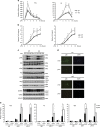A negative feedback loop of ICER and NF-κB regulates TLR signaling in innate immune responses
- PMID: 28009352
- PMCID: PMC5344209
- DOI: 10.1038/cdd.2016.148
A negative feedback loop of ICER and NF-κB regulates TLR signaling in innate immune responses
Abstract
The NF-κB pathway has important roles in innate immune responses and its regulation is critical to maintain immune homeostasis. Here, we report a newly discovered feedback mechanism for the regulation of this pathway by TLR ligands in macrophages. Lipopolysaccharide (LPS) induced the expression of ICER via p38-mediated activation of CREB in macrophages. ICER, in turn, inhibited the transcriptional activity of NF-κB by direct interaction with the p65 subunit of NF-κB. Deficiency in ICER elevated binding of NF-κB to promoters of pro-inflammatory genes and their subsequent gene expression. Mice deficient in ICER were hypersensitive to LPS-induced endotoxic shock and showed propagated inflammation. Whereas ICER expression in ICER KO bone marrow transplanted mice rescued the ultra-inflammation phenotype, expression of a p65 binding-deficient ICER mutant failed to do so. Our results thus establish p38-CREB-ICER as key components of a negative feedback mechanism necessary to regulate TLR-driven inflammation.
Conflict of interest statement
The authors declare no conflict of interest.
Figures




References
-
- Akira S, Hemmi H. Recognition of pathogen-associated molecular patterns by TLR family. Immunol Lett 2003; 85: 85–95. - PubMed
-
- Miggin SM, O'Neill LA. New insights into the regulation of TLR signaling. J Leukoc Biol 2006; 80: 220–226. - PubMed
-
- Moresco EM, LaVine D, Beutler B. Toll-like receptors. Curr Biol 2011; 21: R488–R493. - PubMed
-
- Kawai T, Akira S. TLR signaling. Semin Immunol 2007; 19: 24–32. - PubMed
-
- Han J, Lee JD, Bibbs L, Ulevitch RJ A. MAP kinase targeted by endotoxin and hyperosmolarity in mammalian cells. Science 1994; 265: 808–811. - PubMed
MeSH terms
Substances
LinkOut - more resources
Full Text Sources
Other Literature Sources
Molecular Biology Databases
Research Materials

